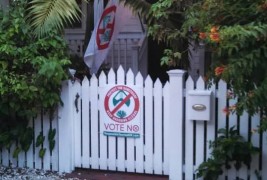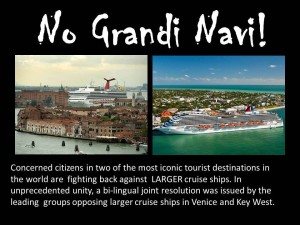Key West Votes NO to Sanctuary Dredging
by Lynn-Marie Smith
Residents of Florida are used to battling developers and businesses that threaten the environment and quality of life in their communities. Key West is certainly no exception. Even if the City Commission tries to pass laws to protect things of value here, some with deep pockets pay lawyers to find loopholes to evade the laws. But the island’s residents scored a victory in the fall of 2013 when they decided the cruise ship industry and its local supporters had gone too far.
The Threat
All it takes is a walk down Duval, our main street, on a day when 1 to 3 ships are in port. You become surrounded by as many as 5,000 people, crowding the sidewalks so locals, as well as visitors who pay to stay in hotels and eat in the restaurants, stay away. I know about the visitors, because I’ve worked in one of Key West’s guesthouses for 10 years. Guests regularly ask me which days there are no cruise ships so they can enjoy our main street. And the idea that cruise ship passengers come back and stay in hotels? Forget it — I could count them on one hand in 10 years.
Now the cruise ship industry is threatening smaller ports with even larger ships, claiming they will withdraw the currently operated smaller ships for financial reasons. The larger ships, of course, require dredging our channel. This is a channel that is directly in the protected Florida Keys National Marine Sanctuary, which includes the only barrier coral reef in North America, and the third largest in the world.
So, knowing that it would take agreement by the Army Corps of Engineers, and eventually a vote by Congress to change the law, the local businesses that most benefit from the ships, with the help of one of the City Commissioners, asked the City Commission to approve a feasibility study on the impact of dredging the Channel. The study was the required first step to changing the law to dredge.
The City Commission
One might say, it’s just a study, why not? Because there have already been studies, one done as recently as 2010 by the Army Corps of Engineers. Table 6 outlines positive and negative effects of dredging, and in terms of environmental impact states, “this project is anticipated to have a significant negative effect on environmental quality.” The Army Corps of Engineers is the same agency that would do the proposed feasible study.
When the City Commission met to discuss the proposed study, so many people from both sides — for and against — crowded the meeting room the Commission finally threw up its hands and decided to put it before the voters as a referendum in the October 2013 mayoral election.
Almost immediately the two sides formed PACS to raise money for their cause. The Key West Chamber of Commerce initiated the Vote Yes movement, and thus called it Support the Study (supportthestudy.com). The Key West Committee for Responsible Tourism initiated the Vote No movement (KWCRT, responsibletourismkw.com). The Commissioners convened a meeting of representatives from both sides and they developed the wording for the Referendum that would go before voters October 1.
The Referendum
“Shall the City of Key West request that the Army Corps of Engineers conduct a comprehensive feasibility study, at no monetary cost to the City, to determine the environmental, economic and social impacts of widening the Key West Main Ship Channel for use by modern and longer cruise ships while also addressing navigational safety?”
The PACS
Each side chose a spokesperson and began fundraising efforts. Support the Study chose a local lawyer, Jennifer Hulse. KWCRT chose a young businessman who was born in Key West, Jolly Benson. Benson had been studying the dredging issue for two years – he had read all the research, all the previous studies, and had talked at length with friends and family in the business and fishing industry. He saw this issue as a turning point – if we let this study happen, the study supporters very well could find a way to change the law and dredge the channel for larger ships.
The Campaign
The KWCRT began holding public events in May, 2013, distributed t-shirts, yard signs, flags and car bumper magnets all summer, and used its Facebook page (Key West Committee for Responsible Tourism) to spread the word through social media. Both groups sent letters to voters who had previously voted absentee, urging them to vote. At first glance this was not an important election for most people. The mayor and the one city commissioner running were popular and likely to win, and the third race was for a new member of the City Utility Board, not of interest to most voters. So getting out the voters was a challenge for both sides.
The PACS sent their representatives to speak and debate at numerous events and meetings. It’s not unfair to characterize the Vote Yes arguments as promoting fear, fear that the cruise ship companies would pull out completely if larger ships couldn’t use the Channel, that hundreds of locals would lose their jobs and that it would eventually ruin the Key West economy. They also refused to take seriously the studies about the environmental impact of the ships on the protected Sanctuary.
The Vote No supporters stuck to the facts, and Jolly Benson used the knowledge he had acquired from reading all the previous research and studies to his advantage, pointing out that the negative environmental impact was very real, and the negative economic impact unlikely. The Vote Yes PAC raised twice as much money as the Vote No PAC, most of it from owners of a private cruise ship pier, harbor pilots, lower Duval St. bars and t-shirt shops, and the tour trains and trolleys that shuttle ship passengers in and out of Old Town.
As October 1, voting day, came closer, the Vote Yes PAC spent liberally on television ads, including during Monday night football, and full-page ads in the local paper. The businesses that benefit from the cruise ship crowds pushed their employees to vote yes, arguing they could lose their jobs if the larger ships couldn’t come to Key West. The Vote No PAC loaded its Facebook page with information about the ill-effects of too many or larger cruise ships on communities. And, of special interest, the KWCRT made alliances with Charleston, South Carolina and Venice Italy — historic communities that, like Key West, are being overwhelmed and damaged by cruise ships.
The Results
My husband and I voted early, as we would be on vacation October 1. I awoke at 5am the morning after the vote, worried about what might have happened, and unable to resist finding out. I went on Facebook and found that the referendum had been defeated by 74%, defeated easily in every District of Key West including that of the sponsoring City Commissioner. I pulled up the Key West Citizen newspaper with the headline: Key West Voters: ‘No Way.’ The turnout was 41%, one of the highest ever, and more people voted for the referendum than voted for the mayor. The once popular mayor barely won, admitting that his support of the study cost him many votes. The people of Key West spoke loudly and clearly – no dredging, no larger cruise ships, we’d had enough.
What Next?
We aren’t naïve enough to believe the larger cruise ship fight is over. The Committee for Responsible Tourism is not dissolving, and its Facebook page is still updated with new information. Not two weeks after the vote the State of Florida released a study implying that, if communities like Key West didn’t improve their infrastructure to accommodate larger ships, the entire state’s tourism would be negatively affected.
Yet, at about the same time, we learn that samples taken near idling cruise ships in New York and three European ports (including Venice) contained dangerously high levels of soot, according to test results released by Friends of the Earth US and the Nature and Biodiversity Conservation Union of Germany.
The referendum vote apparently is not binding for future commissioners, but our hope is that such a strong defeat will make politicians who want to keep their jobs think twice about backing the next proposed study that could inevitably lead to the devastation of our environment and quality of life.
———
Lynn-Marie Smith has had a long career in foundation work, both public and private, including the National Endowment for the Humanities and the Annenberg Foundation Media project in Washington DC. Smith lives in Key West where she volunteers for numerous local non-profit organizations.



Leave a Reply